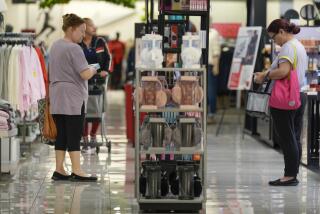Sluggish Retail Sales Signal Edginess of U.S. Consumer
WASHINGTON — More signs emerged Thursday that U.S. consumers are growing increasingly edgy about the economy, with retail sales and a measure of consumer confidence both falling.
Analysts said the weaker-than-expected data, coupled with an unexpectedly large rise in claims for jobless benefits and a report showing tame inflation at the wholesale level, should spur further interest rate cuts from the Federal Reserve as it tries to keep the economy from falling into recession.
The most glaring evidence of weakness came from the March retail sales figures. The Commerce Department said sales at U.S. retailers dipped 0.2%, after a flat reading in February. As sales fell in myriad categories, demand for durable goods--long-lasting items such as cars and refrigerators--was hit especially hard, falling 0.7%.
The March sales drop was the first since November of last year and raised concerns that consumer spending, which constitutes about two-thirds of economic growth, might be running out of steam.
Those worries were fanned by more data, the University of Michigan’s preliminary consumer sentiment index. According to market sources, the index fell to 87.8 in April from 91.5 in March, a steeper-than-forecast drop that brought the measure to its lowest level in more than seven years.
Kathleen Stephansen, director of economic research with Credit Suisse First Boston Corp. in New York, said the trends of slowing sales and lower confidence might begin to feed off each other, a possibility that should worry Fed policymakers.
“If that is not checked, then you can really get into a situation where demand collapses. That is one thing the Fed simply cannot afford,” she said.
The central bank has reduced short-term interest rates a total of 1.5 percentage points already this year in three moves, and it is widely expected to continue on its rate-cutting path. Thursday’s data only reinforced those expectations.
Some economists, including Stephansen, would like to see the Fed cut rates before its next meeting, but the recent stabilization in the stock market, along with a resilient housing sector, seems to have reduced that likelihood.
And Fed officials themselves appear to be more upbeat about the economy’s prognosis. Thomas M. Hoenig, president of the Federal Reserve Bank of Kansas City, sounded an optimistic note to a group of business leaders in Omaha, Neb.
“When it comes to the bottom line . . . the U.S. economy will weather this turmoil,” he said Thursday.
Hoenig also said inflation was “generally contained,” a contention supported by a surprisingly muted reading on the March Producer Price Index, which the Labor Department released Thursday.
Labor said the PPI fell 0.1% in March, aided by a retreat in energy costs. Excluding volatile food and energy prices, the PPI rose by 0.1%.
Analysts said the PPI reading was further proof that the Fed, which has said it is more worried about the risks of a slowing economy than an uptick in inflation, has its priorities straight.
“There’s no 2001 inflation problem, and that gives the Fed the green light to address the economy,” said Ken Mayland, president of consulting firm ClearView Economics in Pepper Pike, Ohio.
Another factor probably weighing on policymakers’ minds is the employment picture. The job market has softened lately, a trend highlighted by weekly data on unemployment claims.
More to Read
Inside the business of entertainment
The Wide Shot brings you news, analysis and insights on everything from streaming wars to production — and what it all means for the future.
You may occasionally receive promotional content from the Los Angeles Times.










